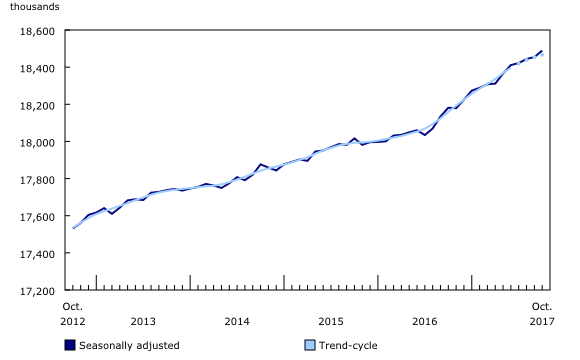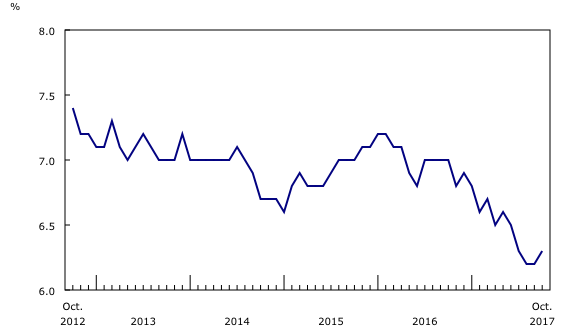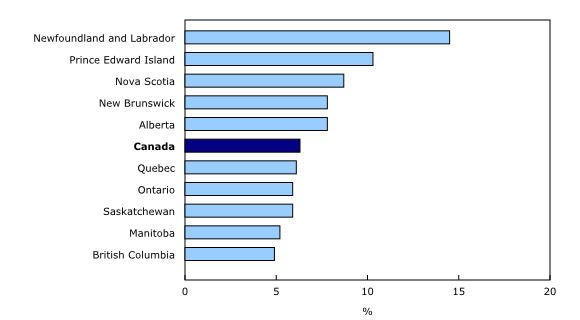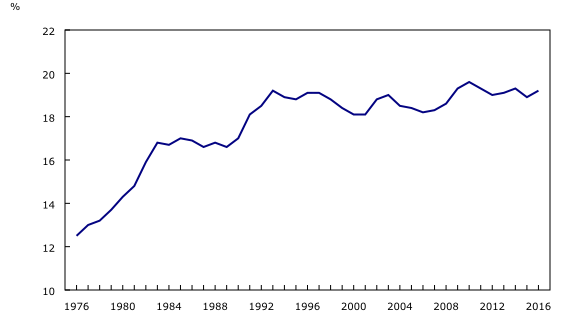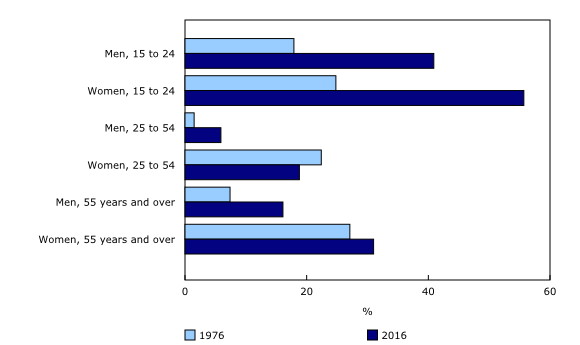Labour Force Survey, October 2017
Archived Content
Information identified as archived is provided for reference, research or recordkeeping purposes. It is not subject to the Government of Canada Web Standards and has not been altered or updated since it was archived. Please "contact us" to request a format other than those available.
Released: 2017-11-03
Employment increased by 35,000 in October, and the unemployment rate rose 0.1 percentage points to 6.3%. Employment gains in the month were driven by full-time work (+89,000), while fewer people worked part time (-53,000).
On a year-over-year basis, total employment rose by 308,000 (+1.7%), with full-time work increasing by 397,000 (+2.7%) and the number of people working part time declining by 89,000 (-2.5%). On a year-over-year basis, total hours worked were up 2.7%.
The unemployment rate trended downwards in the 12 months to October, falling 0.7 percentage points over this period.
Highlights
In October, employment rose for youth aged 15 to 24, while it was little changed for the core-aged population of 25- to- 54 year-olds, and for people 55 and older.
The largest employment increase was in Quebec, followed by Alberta, Manitoba, Newfoundland and Labrador, and New Brunswick. At the same time, there was a decline in Saskatchewan.
Employment rose in several industries, led by "other services;" construction; information, culture and recreation; and agriculture. Employment declined in wholesale and retail trade.
The number of private sector employees increased in October, while public sector employment and self-employment were little changed.
More youth working or searching for work
There were 18,000 more youths aged 15 to 24 employed in October, with all of the growth in full-time work. At the same time, their unemployment rate rose 0.8 percentage points to 11.1%, as more of them searched for work. On a year-over-year basis, employment for youth was virtually unchanged, while their unemployment rate fell 1.8 percentage points.
Despite more youth in the labour market in October, their participation rate—that is, the proportion working or searching for work—trended downwards in the 12 months to October, falling 0.8 percentage points to 63.7%. This rate was down for young men and edged down for young women. Overall, the participation rate among youth has remained lower than the average of 67% in 2007 and 2008, just prior to the economic downturn. Part of this decline is associated with social and economic factors such as increased school attendance and delayed entry into the labour market compared with previous generations. For more information on these trends, see "Youth Labour Force Participation: 2008 to 2014."
Employment holds steady for core-aged women and men
Total employment for core-aged 25- to 54-year-olds held steady in October, while their unemployment rate fell 0.2 percentage points to 5.4%. Employment for this group was up 174,000 (+1.5%) compared with 12 months earlier.
Among core-aged women, more worked full time (+32,000) in October, while the number working part time declined (-25,000). Their unemployment rate was little changed, at 5.1%. On a year-over-year basis, employment for this group rose 106,000 (+1.9%).
For men in the core-age group, part-time employment increased by 23,000 in October, while full-time employment was little changed. Their unemployment rate fell 0.3 percentage points to 5.6%, as fewer of them searched for work. Employment growth among this group totalled 68,000 (+1.1%) in the 12 months to October.
Employment for people 55 and older little changed in the month
Employment was little changed for people aged 55 and older, while their unemployment rate increased 0.3 percentage points to 5.7% as more of them—particularly men—searched for work. The unemployment rate for men in this age group was 6.2%, while it was 5.1% for women. On a year-over-year basis, 130,000 (+3.4%) more people aged 55 and older were working, largely the result of the continued transition of the baby-boom cohort into this older age group.
Among workers aged 55 and older, 8 in 10 were between the ages of 55 and 64. The estimated year-over-year employment growth rate for this group (unadjusted for seasonality) was 2.3%, relatively in line with their population increase (+2.0%). In comparison, people aged 65 and older comprised a smaller share of older workers, but their proportion has been increasing over the past decade. This group had the fastest year-over-year employment growth rate among the major demographic groups in October, rising 8.7% and outpacing their rate of population growth (+3.7%). For more information about recent trends among older workers, see "The impact of aging on labour market participation rates."
Provincial overview
The largest employment increase in October was in Quebec (+18,000). Full-time employment increased (+33,000), while part-time employment edged down. The unemployment rate was virtually unchanged at 6.1%, following a notable downward trend since the start of 2016. On a year-over-year basis, employment in Quebec was up by 67,000 (+1.6%).
Employment rose by 12,000 in Alberta, all in full-time work. At the same time, the unemployment rate was little changed at 7.8%. Compared with 12 months earlier, employment in the province was little changed (+17,000 or +0.7%) and the unemployment rate declined by 0.8 percentage points. The unemployment rate in Alberta has not fully rebounded to what it was in the fall of 2014, just prior to the oil-related downturn. The unemployment rate was 4.4% in November 2014 and reached a peak of 9.0% in November 2016.
In Manitoba, employment increased by 4,000 in October and the unemployment rate was down 0.3 percentage points to 5.2%. The unemployment rate had been on a strong downward trend from the fall of 2016 to the summer of 2017. On a year-over-year basis, employment in this province increased by 14,000 (+2.3%).
Employment in Newfoundland and Labrador rose by 3,400 in October, the first monthly increase in nine months. The unemployment rate in the province edged down to 14.5%. Employment in Newfoundland and Labrador was down on a year-over-year basis (-4,700 or -2.1%).
For New Brunswick, employment was up by 2,300 in October, and the unemployment rate held steady at 7.8%. Compared with 12 months prior, employment in the province was virtually unchanged. The unemployment rate fell 2.0 percentage points, as fewer people searched for work and the number of people participating in the labour market declined.
Employment declined in Saskatchewan by 4,000 in October, while the unemployment rate decreased 0.3 percentage points to 5.9%. All of the employment decline was in full-time work. On a year-over-year basis, employment in the province was virtually unchanged, while the unemployment rate declined 1.1 percentage points. Like Alberta, the unemployment rate in Saskatchewan has not returned to the rates observed in the fall of 2014, just prior to the oil-related downturn. The unemployment rate was 3.5% in November 2014 and reached a high of 7.0% in October 2016.
In Ontario, employment was virtually unchanged in October, while the unemployment rate increased 0.3 percentage points to 5.9% as more people searched for work. On a year-over-year basis, employment in the province rose by 149,000 (+2.1%) and the unemployment rate fell 0.5 percentage points.
Employment in British Columbia was also little changed in October. Employment in the province has held steady since June 2017, following a strong upward trend which began in the spring of 2016. On a year-over-year basis, employment in the province was up by 64,000 (+2.7%) and the unemployment rate fell 1.2 percentage points to 4.9%.
Industry perspective
Employment was up by 21,000 in the "other services" industry in October. Compared with 12 months earlier, employment in this industry was little changed. "Other services" include services such as those related to civic and professional organizations, and personal and laundry services.
In construction, employment rose by 18,000 in October. Compared with October 2016, employment in construction was virtually unchanged.
There were 15,000 more people working in information, culture and recreation industries in October. On a year-over-year basis, employment in this industry was little changed.
In October, employment in agriculture increased by 6,100, reaching a level similar to that observed in October 2016.
Employment in professional, scientific and technical services was little changed in the month, but this industry was the fastest growing on a year-over-year basis, up 85,000 or 6.1%. Much of the year-over-year increase was in computer system design services.
Manufacturing employment edged up in October (+7,800) and was up by 51,000 (+3.0%) on a year-over-year basis. Employment in this industry has been on an upward trend since the start of 2017. The increase in the 12 months to October was mostly attributable to subsectors such as electrical equipment, appliance and component manufacturing.
Employment was down by 36,000 in trade, mostly in wholesale. On a year-over-year basis, employment in this industry was up by 47,000 (+1.7%).
The number of private sector employees rose by 39,000 in October, while public sector employment was little changed. Compared with 12 months earlier, the number of private sector employees increased by 165,000 (+1.4%) and public sector employment rose by 83,000 (+2.3%).
Self-employment was little changed in October, but was up by 60,000 (+2.1%) on a year-over-year basis.

In celebration of the country's 150th birthday, Statistics Canada is presenting snapshots from our rich statistical history.
Evolution of part-time employment
For some workers, part-time employment is a voluntary choice to help balance paid work with other responsibilities and preferences, while for others it is an involuntary consequence of factors such as a lack of suitable full-time employment. In the Labour Force Survey, part-time employees are persons who usually work less than 30 hours per week at their main or only job.
Over the last 40 years, the proportion of people working part time (the part-time rate) has increased by 6.7 percentage points, from 12.5% of all employment in 1976 to 19.2% in 2016. Most of this change occurred in the first half of the period, before the mid-1990s. The part-time rate tends to increase during periods of economic recession, including the early 1980s, the early 1990s and the 2008-2009 downturn.
Women more likely to work part time than men
Since 1976, the part-time employment rate has increased by 6.7 percentage points among men, compared with 2.8 percentage points for women. This has somewhat narrowed the gap in part-time rates, but women are still twice as likely as men to work part time. In 2016, 26.4% of employed women aged 15 and over worked part-time, compared with 12.6% of men. The reasons that women and men work part-time generally differ, with women being more likely to work part-time voluntarily and to cite child care as the main reason for doing so. For more information, see "Women and Paid Work."
Part-time employment rate up the most for youth
The largest change in the part-time rate has occurred among people aged 15 to 24, increasing from 21.1% in 1976 to 48.3% in 2016. Unlike the older age groups, the increase in the number of youth working part time occurred in parallel with a decrease in their overall employment, resulting in a more dramatic change in the part-time rate. The share of youth working part time during the school year was little changed among full-time students, while it increased among non-students and part-time students over the 40-year period.
The next largest increase in the part-time rate was among people aged 55 and older. In this age group, the share of part-time workers increased from 13.3% in 1976 to 22.9% in 2016. Among men, it increased by 8.8 percentage points to 16.1% in 2016, compared with an increase of 3.9 percentage points to 31.0% for women.
The part-time rate is lowest among people in the core age group of 25 to 54. The rate increased by 3.3 percentage points over the period to reach 12.1% in 2016. Among men in this age group, the share of part-time workers increased by 4.4 percentage points to 5.9%, while it fell by 3.6 percentage points to 18.8% among women. This decline is consistent with an increase in the average weekly work hours of core-age women over the last few decades, particularly among mothers with young children.
Sustainable Development Goals
On January 1, 2016, the world officially began implementation of the 2030 Agenda for Sustainable Development — the United Nations' transformative plan of action that addresses urgent global challenges over the next 15 years. The plan is based on 17 specific sustainable development goals.
The Labour Force Survey is an example of how Statistics Canada supports the reporting on the Global Goals for Sustainable Development. This release will be used in helping to measure the following goals:


Note to readers
The Labour Force Survey (LFS) estimates for October are for the week of October 8 to 14.
The LFS estimates are based on a sample and are therefore subject to sampling variability. As a result, monthly estimates will show more variability than trends observed over longer time periods. For more information, see "Interpreting Monthly Changes in Employment from the Labour Force Survey." Estimates for smaller geographic areas or industries also have more variability. For an explanation of the sampling variability of estimates and how to use standard errors to assess this variability, consult the "Data quality" section of the publication Labour Force Information (71-001-X).
This analysis focuses on differences between estimates that are statistically significant at the 68% confidence level.
The LFS estimates are the first in a series of labour market indicators released by Statistics Canada, which includes indicators from programs such as the Survey of Employment, Payrolls and Hours (SEPH), Employment Insurance Statistics, and the Job Vacancy and Wage Survey. For more information on the conceptual differences between employment measures from the LFS and SEPH, refer to section 8 of the Guide to the Labour Force Survey (71-543-G).
The employment rate is the number of employed people as a percentage of the population aged 15 and older. The rate for a particular group (for example, youths aged 15 to 24) is the number employed in that group as a percentage of the population for that group.
The unemployment rate is the number of unemployed people as a percentage of the labour force (employed and unemployed).
The participation rate is the number of employed and unemployed people as a percentage of the population.
Full-time employment consists of persons who usually work 30 hours or more per week at their main or only job.
Part-time employment consists of persons who usually work less than 30 hours per week at their main or only job.
Seasonal adjustment
Unless otherwise stated, this release presents seasonally adjusted estimates, which facilitate comparisons by removing the effects of seasonal variations. For more information on seasonal adjustment, see Seasonally adjusted data – Frequently asked questions.
Chart 1 shows trend-cycle data on employment. These data represent a smoothed version of the seasonally adjusted time series, which provides information on longer-term movements, including changes in direction underlying the series. These data are available in CANSIM table 282-0087 for the national level employment series. For more information, see the StatCan Blog and Trend-cycle estimates – Frequently asked questions.
Next release
The next release of the LFS will be on December 1.
Products
A more detailed summary, Labour Force Information (71-001-X), is now available for the week ending October 14.
More information about the concepts and use of the Labour Force Survey is available online in the Guide to the Labour Force Survey (71-543-G).
The updated Labour Market Indicators dashboard (71-607-X) is now available. This new, interactive dashboard provides easy, customizable access to key labour market indicators. Users can now configure an interactive map and chart showing labour force characteristics at the national, provincial or census metropolitan area level.
Contact information
For more information, contact us (toll-free: 1-800-263-1136; 514-283-8300; STATCAN.infostats-infostats.STATCAN@canada.ca).
To enquire about the concepts, methods or data quality of this release, contact Andrew Fields (613-951-3551; andrew.fields@canada.ca), Gordon Song (613-793-2392; gordon.song@canada.ca), or Client Services (toll-free: 1-866-873-8788; statcan.labour-travail.statcan@canada.ca), Labour Statistics Division.
- Date modified:




